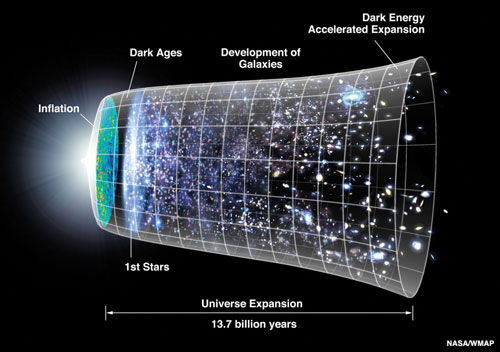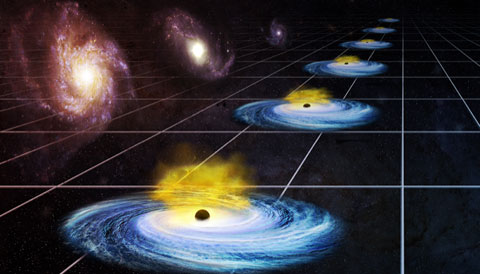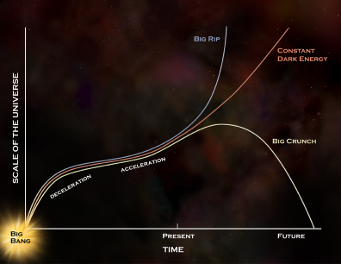Astronomers have found a way to turn quasars into standard candles, with potentially far-reaching implications for the nature of mysterious dark energy.

NASA / WMAP
The weird repulsive force has left its fingerprints on the earliest photons we can see, the ones emitted as part of the cosmic microwave background (CMB), when the infant universe was only 370,000 years old. Yet dark energy only began to dominate expansion as the universe entered middle age, after 9 billion years or so.
Now, Guido Risaliti (University of Florence and INAF-Astrophysical Observatory of Arcetri, Italy) and Elisabeta Lusso (Durham University, UK) are using quasars to probe the cosmology of our universe’s relatively unexplored adolescence. The results, appearing in the January 28th Nature Astronomy, promise to reveal dark energy's true nature.
The leading explanation for dark energy has long been the cosmological constant, also known as vacuum energy. This energy inherent to empty space arises from quantum theory, which says that even when space appears empty of particles, it’s actually filled with quantum fields. These fields exert a negative pressure that counteracts the attractive force of gravity. However, calculations of vacuum energy overpredict the measured dark energy density by an astounding 120 orders of magnitude (that’s a 1 followed by 120 zeroes!). That the cosmological constant remains the favorite theory speaks to how little we understand dark energy — and how difficult the measurements involved are.
Studying the universe at any age starts with gauging cosmological distance — the farther we look, the further back in time we see — but we can’t just roll out a tape measure to the stars. Enter standard candles, objects for which we can measure an intrinsic luminosity. By comparing how bright a standard candle appears to be with how bright it really is, we can determine its distance without knowing anything about cosmology.
Type Ia supernovae have long been the brightest of standard candles. Observations of these detonating white dwarfs led to the Nobel-winning discovery of accelerating expansion announced back in 1998. The supernovae extended our reach to when the universe was a third of its current age. That’s a pretty good tape measure! Nevertheless, it only probes the era when dark energy began to dominate the universe’s expansion. To see farther back, and probe the era when dark energy overtook matter, astronomers need something even more luminous.
Quasars as Standard Candles

NASA / CXC / M. Weiss
What’s more luminous than an exploding star? A gas-guzzling supermassive black hole would do the trick. After all, quasars are brilliant enough to be seen from a universe less than a billion years old, making them prime targets for reaching earlier epochs.
Unfortunately, quasars also exhibit a bewildering variety of forms — astronomers have long thought they were anything but standard. Case in point: Astronomers have known for the past 30 years that more visibly luminous quasars emit relatively fewer X-rays, but there was too much variance from one quasar to another to pin down any one quasar's intrinsic brightness.
Risaliti and Lusso realized that this relation between the emission of X-rays and visible light must arise from the physics of quasar accretion disks. The disk itself emits visible light, while a hot, gaseous corona emits the X-rays. The two are intertwined by straightforward physics; it's just that previously, contaminants had been mucking things up. So for this study, Risaliti and Lusso removed any sources where disk emission is obscured (by dust or gas) or contaminated (by emission from a fast-flowing black hole jet). Their careful selection results in a much tighter, more useful relation. Using data from the Sloan Digital Sky Survey and the XMM-Newton, Chandra, and Swift space telescopes, the duo then apply the relation to turn 1,600 quasars into standard candles.

NASA / CXC / M.Weiss
The quasars help Risaliti and Lusso fill in the gap along the cosmic timeline, looking back to an adolescent universe only a billion years old. From this data, the team finds that dark energy is actually increasing over cosmic time.
The results appear to rule out the cosmological constant, which predicts a constant energy density. That’s a bit of a relief given that vacuum energy overpredicts the observations so badly. (Did I mention the 120 orders of magnitude?) Evolving dark energy may also help resolve an ongoing tension between measurements of the universe’s current expansion rate.
Nevertheless, the results are unsettling from a philosophical standpoint: If dark energy density really does increase over time, then so does the repulsive force it exerts, potentially ending our universe in a Big Rip.
Too Early To Tell
Let’s not give up on the universe just yet, though. Phil Hopkins (Caltech), who wasn’t involved in the study, urges caution in interpreting its results. The relation that Lusso and Risaliti use to turn quasars into standard candles may itself evolve over time, making those quasars not so standard. For example, if quasars slow their gas-guzzling as mergers become less frequent, that might change the shape of the relation between the emission of X-rays and visible light. “[The relation] only needs to evolve a little bit to explain these observations,” he adds.
That said, Hopkins agrees the results are interesting and worth following up with even bigger and better samples. The authors also note that other studies probing the adolescent universe are forthcoming. The bar is high these days for disproving the standard cosmological model, and only time and additional study will tell if this is the method that will do it.
 7
7









Comments
Alan Potts
February 1, 2019 at 6:05 pm
A good article Monica!
I have been a proponent for some time of an alternate explanation of apparent "dark energy" for some time.
If we assume the constants such as G, h, c are constant irrespective of the density of enrgy/matter in the universe then the observations initiated by Type Ia Supernovae are fine and the standard candles are indeed standard, irrespective of cosmic epoch.
However, if say G were to decrease with cosmic epoch, white dwarfs (the exploding part of the binary in a double-star system as they exceed the Chandresakher limit) and implode to a neutron star may implode with less matter if G were higher in early epochs. Hence the explosion would appear (from the electromagnetic force) less bright than a nearby exploding white dwarf (the ones used to calibrate the candles). On that basis, I have argued, the calibration of standard candles may be be in error.
It may be h and or c...or G, h and c that are functions of cosmic epoch. Any of them would, if evolving, change the physics of exploding white dwarfs. And remove the problem we call 'dark energy' which is well beyond any physics explanation.
So, open hearts (hmm) and open minds. The truth is out there. But what is that truth?
This is why we 'do' science!
You must be logged in to post a comment.
Peter Wilson
February 4, 2019 at 9:40 am
That's been looked at before, and never really gained traction. Also, the idea is not as simple as you might imagine. "Change" is relative; it only has meaning with respect to something that does not change, or is constant. So when you talk about "changing constants," you've stepped into epistemological quick-sand. But help is on its way...
You must be logged in to post a comment.
Edward Schaefer
February 5, 2019 at 11:21 am
At one point, I played around with a theory under which c (and other "constants") changed over time in a fairly dramatic way. I soon realized that such changes could be seen in the fine structure constant as measured in distant galaxies. I looked for and found studies where the such measurements had been made. They indicated that the fine structure constant has indeed been constant over a substantial part of the age of the universe.
So much for that theory.
You must be logged in to post a comment.
Edward Schaefer
February 5, 2019 at 11:28 am
Monica -
At the start of the second paragraph, you wrote "this repulsive force". Dark energy is not a force, but instead a field. The objects being made to move away from each other are not responding to or feel any force. Instead the space between them is increasing over time.
In general relativity, gravitation acts through the geometry of spacetime, not through any force. Even the graviton does not transmit any force, but instead it transmits changes in spacetime curvature. So kindly watch your semantics.
You must be logged in to post a comment.
Peter Wilson
February 5, 2019 at 12:17 pm
"The leading explanation for dark energy has long been the cosmological constant, also known as vacuum energy. This energy inherent to empty space arises from quantum theory, which says that even when space appears empty of particles, it’s actually filled with quantum fields. These fields exert a negative pressure that counteracts the attractive force of gravity."
So dark energy not only powers the expansion of space...it creates more of itself in the process? Interesting...
You must be logged in to post a comment.
Edward Schaefer
February 5, 2019 at 2:07 pm
Kindly cite what you are quoting.
The writer of that quote is making the same mistake as Monica: Treating gravitation as being due to a force, which the cosmological constant is counteracting with another force (in the case "pressure"). Once again, in General Relativity (GR) the movement of objects is due to the geometry of spacetime and changes in said geometry. Period. No forces are involved.
For example, the Earth is following an inertial path (or straight worldline) as it goes around the Sun. In GR, the geometry of spacetime around the Sun is what keeps the Earth in orbit.
The expectation that things like being kept in orbit and galaxies being push apart being due to a force is left over from Newtonian physics. I know that treating such things as being due to forces is much easier for people to understand, but that does not make that treatment correct. In a place like Sky and Telescope, where some readers are truly trying to understand what is really going on, I strongly believe that the focus should be on being as correct as possible. That means avoiding treating the expansion of the universe as being due to a force.
You must be logged in to post a comment.
Peter Wilson
February 6, 2019 at 10:06 am
I am quoting Monica, above. She has nicely paraphrased the standard-model paradigm. If it doesn't sound right, that's what the dark energy enigma is all about!
You must be logged in to post a comment.
You must be logged in to post a comment.